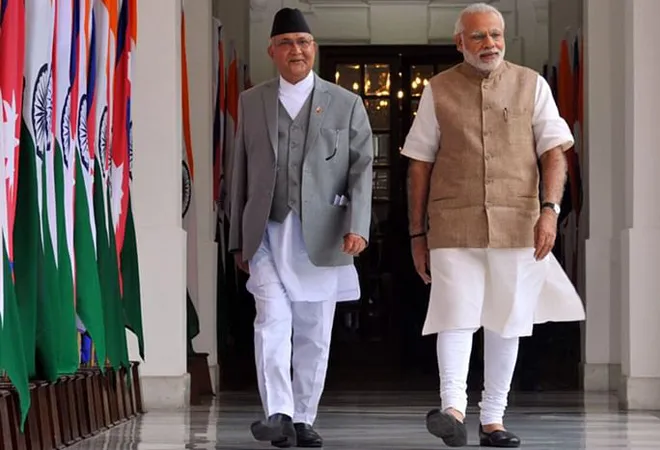
On November 20, Nepal is slated to conduct general elections for the federal parliament and the provincial assemblies. Since the passage of the 2015 Constitution, this is the second democratic election in the politically tumultuous Himalayan Republic. Nepal would vote to elect members of the 275 members of Parliament and 330 members of seven provincial assemblies. The Nepali Congress led by Prime Minister Sher Bahadur Deuba, the Communist Unified Marxist-Leninist (UML) party led by KP Sharma Oli and the Maoist Centre led by Pushpa Kamal Dahal are the
main political players in the electoral fray.
Analysts predict a hung Parliament, like the 2017 elections which gave Oli’s CPN-UML and Prachanda’s Maoist party a decisive mandate to govern. Incidentally, the decisive mandate was largely secured by Oli and his alliance partners by effectively resonating Nepali grievances against a six-month long border blocked allegedly imposed by New Delhi. Since then, especially after Deuba became prime minister, the relationship between the two closest neighbours have improved. However, the alliance led by Oli is still using anti-India rhetoric. Thus, irrespective of what India does to Kathmandu, it is very difficult to remove the India factor from the domestic politics of the Himalayan republic.
The ‘India factor’ in Nepali Elections
The compulsion of winning elections in democratic politics often rakes up the issue of safeguarding the ‘national interest’ from an ‘external entity.’ India (and lately China) has often played the role of that ‘external factor’ in Nepal’s political discourse. This is primarily due to two paradoxical as well as inter-related factors. First, India and Nepal are often hailed as the ‘world’s closest neighbours’ due to an extremely unique geography. Nepal and India share an 1800-km-long open border, and the citizens of both the countries are allowed to travel, work and reside freely on either side of the border. Moreover, the people on both sides of the border share deep-rooted historical, cultural and religious ties. A sizeable section of Nepal’s Gorkha population are serving as soldiers in the Indian army. As a goodwill gesture, Nepal’s army chief is designated as honorary general of the Indian army and the same mark of respect is reciprocated to the Indian army chief.
The compulsion of winning elections in democratic politics often rakes up the issue of safeguarding the ‘national interest’ from an ‘external entity.’ India (and lately China) has often played the role of that ‘external factor’ in Nepal’s political discourse.
Second, geo-strategically, India has a hegemonic presence in Nepal as it shares a border with India on its east, west and south. Also, the India-Nepal Treaty of Peace and Friendship of 1950 has been a prolonged contentious issue in the relations between the two countries as Nepal has perceived the treaty as an instrument for India to influence or interfere in its domestic affairs, especially in the pivotal areas of foreign policy and security. Herein lies the paradox. India, with its military, geopolitical, and economic heft as well as due to cross-border people-to-people ties in the region is often seen as a power responsible for providing assistance in the developmental architecture of Nepal. On the other hand, there is a constant apprehension on Nepal’s part, that owing to India’s dominant position, it might interfere in Nepal’s internal political-economic decisions, threatening the sovereignty and autonomy of Nepal. It is often perceived that in order to check India’s overarching presence in Nepal’s diplomatic priorities, Nepal many a times look up to another powerful Asian neighbour, China, for developmental needs and economic assistance. As India and China are locked in territorial conflicts and geo-strategic competition over expanding their respective influence in the South Asian region, Nepal’s balancing tactic between India and China, many a times, implicitly rakes up suspicion in the mind of the Indian government.
The topmost leadership of major parties are accused of siding with one big power over the other and is often derided for compromising national interest for doing the bidding of the bigger powers. While KP Oli is known for his inclination towards China, Sher Bahadur Deuba is seen to be close to India. Such a discourse of the presence of the ‘India factor’ in Nepal’s elections has been a constant element of its democratic politics in which concerns of ‘national interest and sovereignty’ plays an extremely emotive role for galvanising electoral support for Nepal’s political elite. KP Oli and his alliance partners made huge political gains on anti-India campaigns over the 2015 blockade.
Key drivers shaping the ‘India factor’ in this election
The upcoming election is expected to witness the influence of this very ‘India factor’ for a host of territorial, geo-strategic as well as ethno-cultural developments that has marked Indo-Nepal relations in the last few years. First, the
outstanding border disputes between the two countries were raked up once again in 2020 when Nepal raised concern over India’s construction of a new 80-km road in the Himalayas near the Lipulekh pass, claiming that the road intersects the land which Nepal considers as their own territory. Nepal took a slew of measures to register its protest that included deploying police forces in the region, summoning of the Indian envoy in Nepal, and the passing of an amendment to reiterate its claim of almost 400 km in the border region. From India’s point of view, the construction of the road was crucial as it is of immense strategic significance as it is the quickest link between Delhi and the Tibetan plateau. The road is also India’s priority as it is an important route for Hindu pilgrims from India to visit the sacred Mount Kailash. The issue of competing territorial claims was manifested in Nepal’s outrage over the Indian government’s publication of a new political map that included territories claimed by Nepal, triggering huge resentment against India, which has been reflected in the social media hashtag #BackoffIndia in Nepal.
Second, the competitive geo-strategic conflict between India and China over developmental projects and economic assistance
heavily shapes the political dynamics in Nepal. A careful balancing act between the two countries has remained one of the major challenges for Nepal’s political elite, in which China’s growing influence looms large. In 2018, Nepal refrained from attending the BIMSTEC counter-terrorism exercise in apprehension that it would be perceived as an anti-China stance. Nepal has also reportedly faced reservation from China to receive grants from the US for developing its electricity transmission system and linking it with the Indian power grid. There are also apprehensions that China has also
intervened in Nepal’s coalition politics in order to ensure the stability and strengthening of the communist forces in Nepal’s political landscape.
A careful balancing act between India and China has remained one of the major challenges for Nepal’s political elite, in which China’s growing influence looms large.
Third, Nepal’s cross-border cultural and ethnic linkages might also have a bearing on Nepal’s upcoming elections in two ways. First, the Madhesi movement and the subsequent blockade by India in 2015 have had a deep impact on India-Nepal relations and the episode has revealed how the strong cross-border ethnic ties between the people residing in the geographically proximate border regions of two countries might have the propensity to shape Nepal’s domestic political affairs. The blockade also is
perceived to have aggravated the anti-India sentiment in Nepal and compelled the Nepalese government to tilt towards China for assistance. Second, the political
rise and consolidation of the pro-Hindu party, the Bharatiya Janata Party, in neighbouring India is understood to have some bearing in the rise of Hindu identity cultural politics in Nepal. Though the country’s democratic politics has not yet witnessed explicit political mobilisation on religious lines, the increasing discourse of religion-based politics is visible as top leaders have promised the building of temples in the electoral agenda, in a society where 80 percent of the population are Hindus.
Conclusion
To sum up, the politics of Nepal is not only inextricably linked to the historical and cultural cross-border dynamics with India, but is also shaped by the geo-political tussle between India and China in the region. On the one hand, Nepal’s political elite, cutting across party lines, will always be compelled to weigh in the ‘India factor’ in their political strategy as competitive democratic mobilisation and nationalism becomes the modus operandi of Nepal’s politics. However, the significance of India’s constructive role in democratic consolidation and developmental priorities, given the geographical-cultural proximity, cannot be undermined and the new government will also be mindful of that. On the other hand, India’s restrained and responsible approach to facilitate a stable democratic process in Nepal after decades of turbulence, will not only enhance India’s goodwill in the region but also will provide stability in Nepal and beyond.
The views expressed above belong to the author(s). ORF research and analyses now available on Telegram! Click here to access our curated content — blogs, longforms and interviews.



 On November 20, Nepal is slated to conduct general elections for the federal parliament and the provincial assemblies. Since the passage of the 2015 Constitution, this is the second democratic election in the politically tumultuous Himalayan Republic. Nepal would vote to elect members of the 275 members of Parliament and 330 members of seven provincial assemblies. The Nepali Congress led by Prime Minister Sher Bahadur Deuba, the Communist Unified Marxist-Leninist (UML) party led by KP Sharma Oli and the Maoist Centre led by Pushpa Kamal Dahal are the
On November 20, Nepal is slated to conduct general elections for the federal parliament and the provincial assemblies. Since the passage of the 2015 Constitution, this is the second democratic election in the politically tumultuous Himalayan Republic. Nepal would vote to elect members of the 275 members of Parliament and 330 members of seven provincial assemblies. The Nepali Congress led by Prime Minister Sher Bahadur Deuba, the Communist Unified Marxist-Leninist (UML) party led by KP Sharma Oli and the Maoist Centre led by Pushpa Kamal Dahal are the  PREV
PREV



